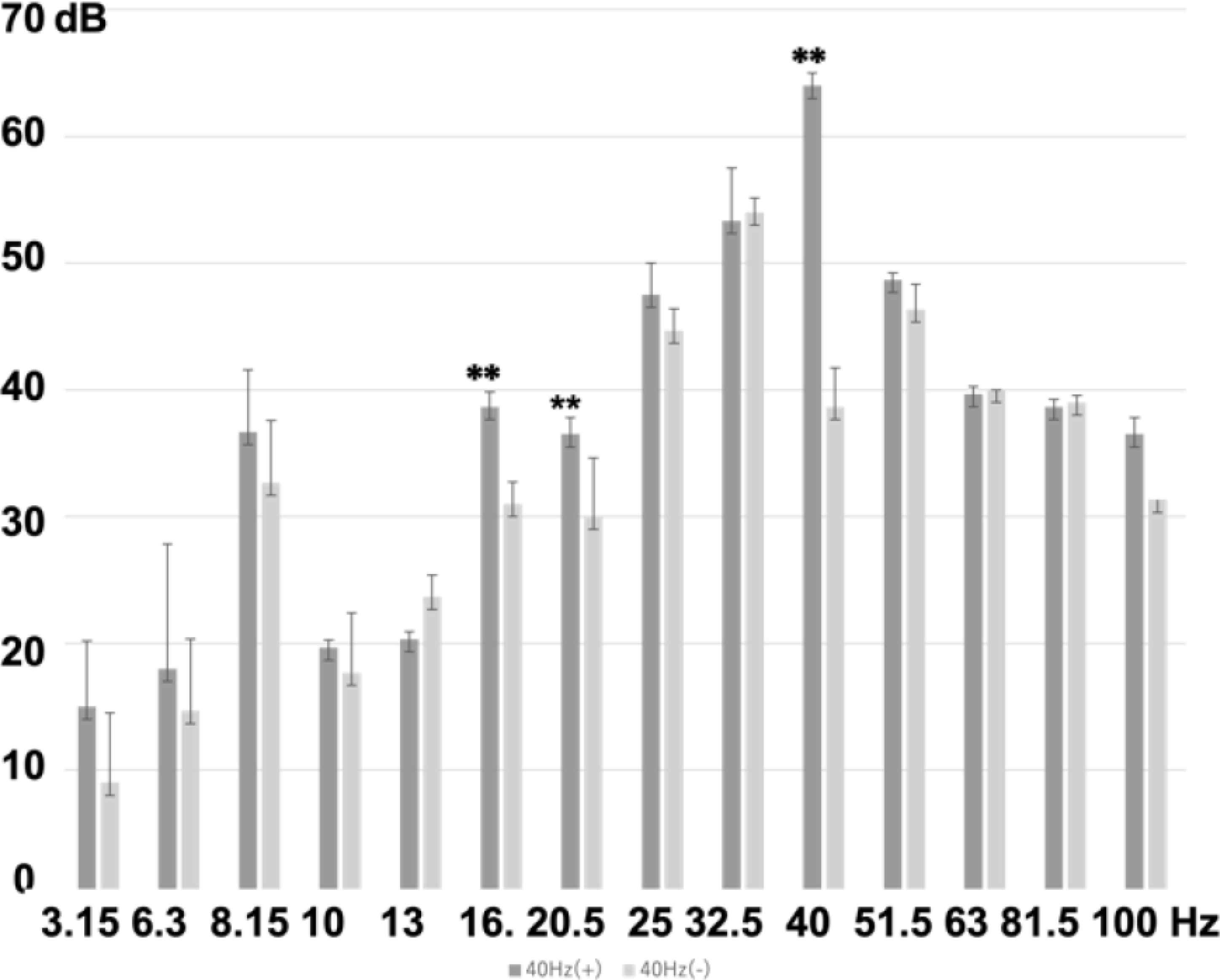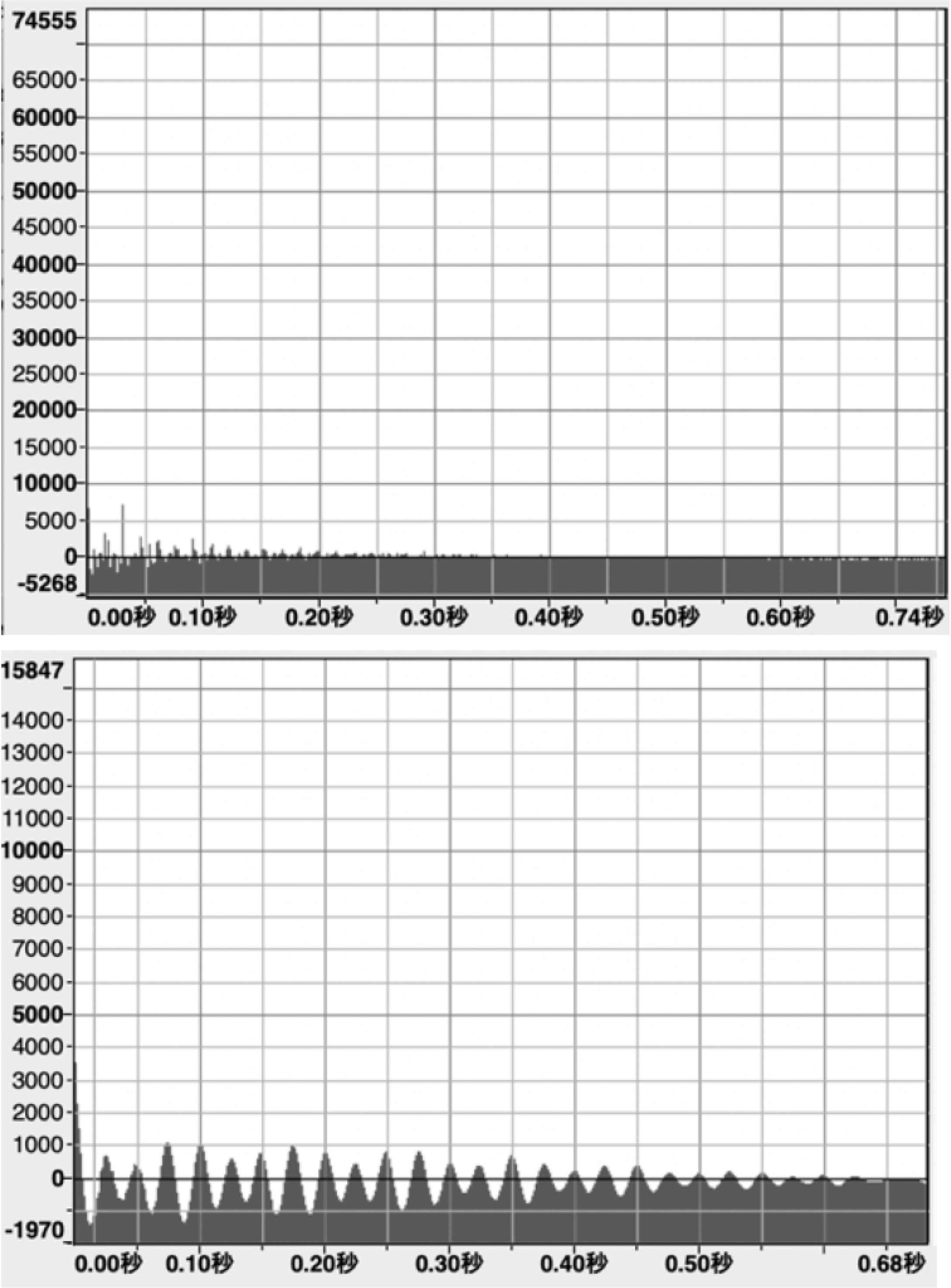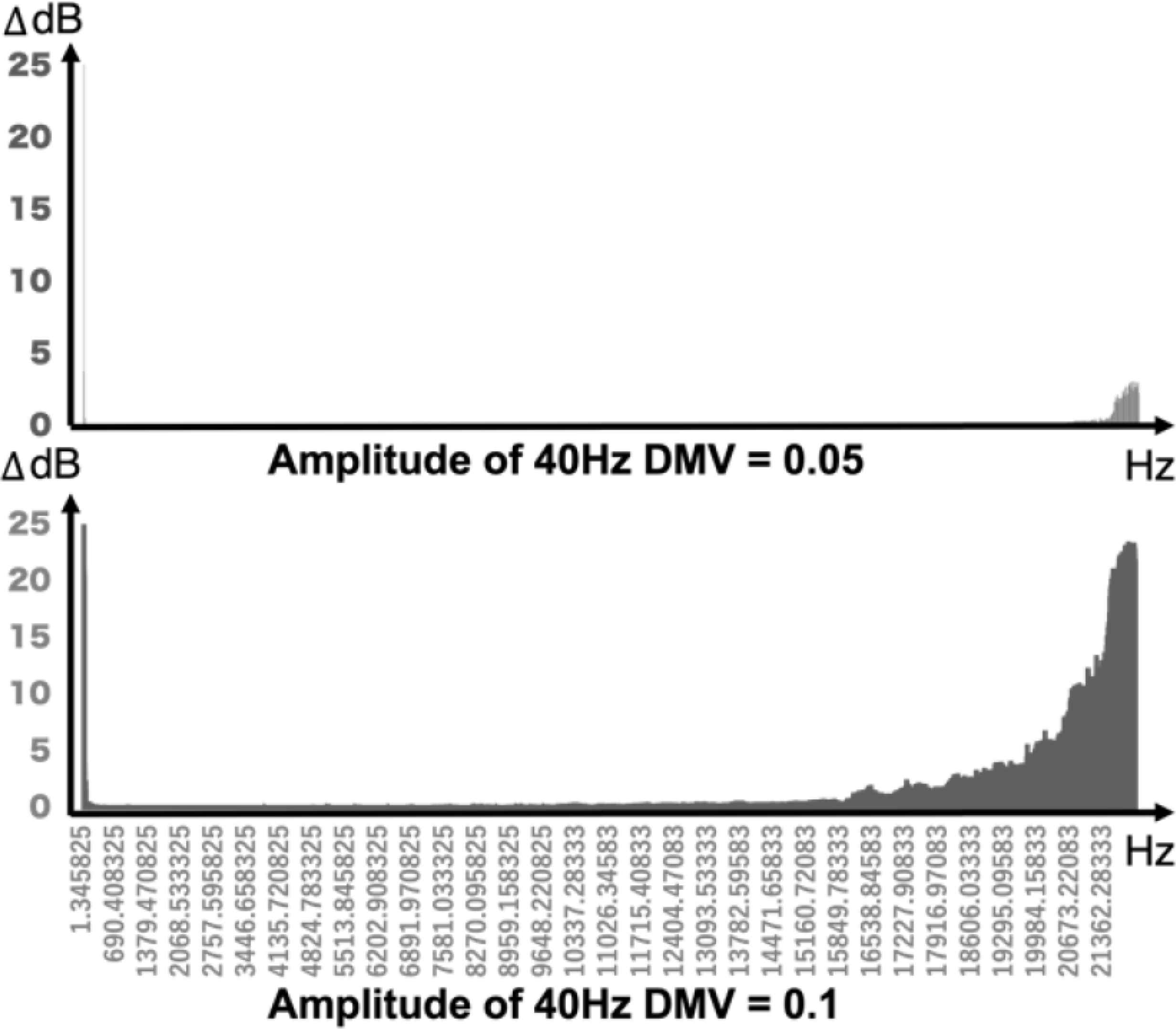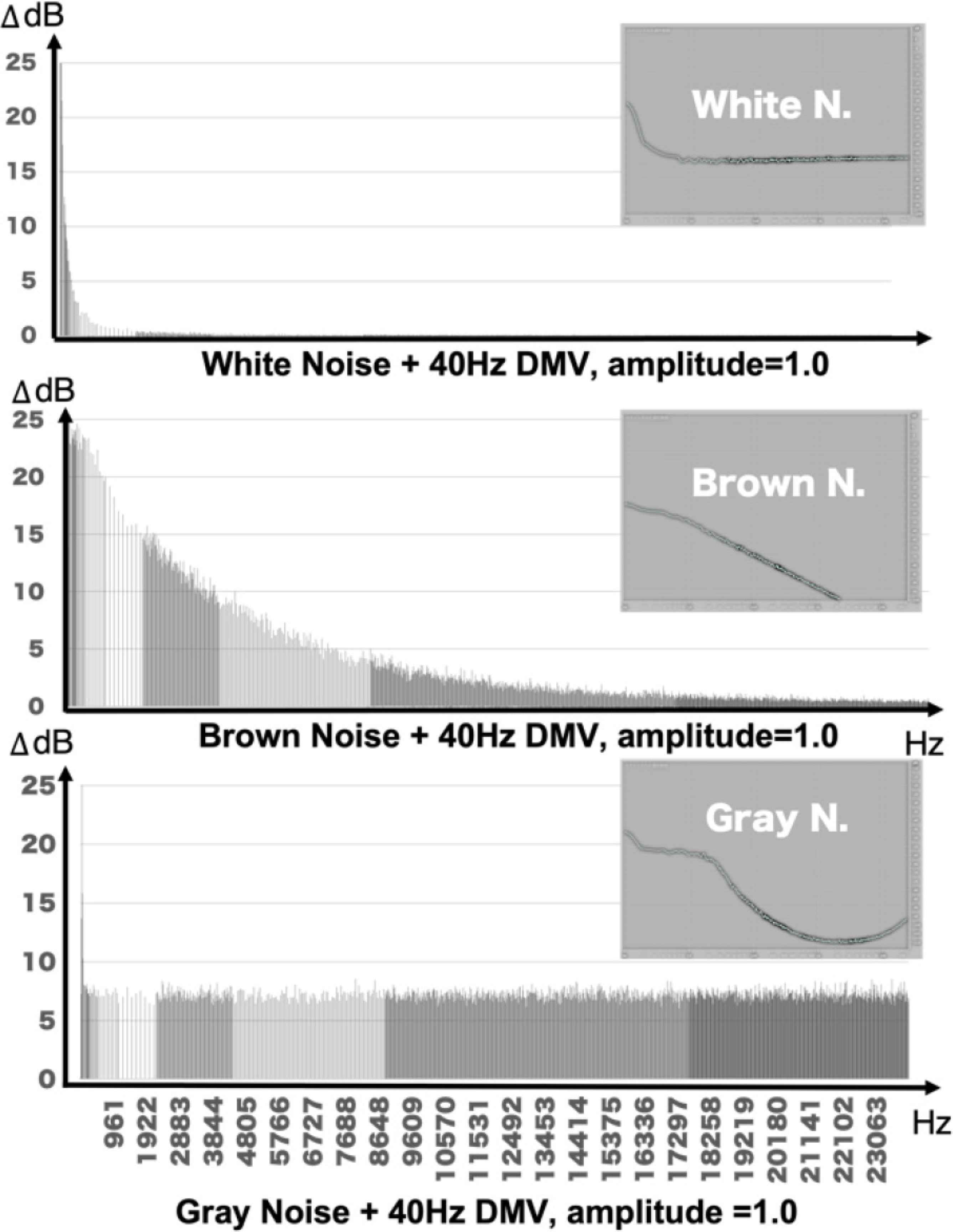Effects of Mixing Low-frequency Waves - Deep Micro Vibrotactile with Sounds
- DOI
- 10.2991/jrnal.k.211108.012How to use a DOI?
- Keywords
- Autocorrelation of sound; deep micro vibrotactile; DMV; low-frequency sound
- Abstract
Little is known about the role of low-frequency components in sound. The case of a 40 Hz sine wave mixed with music or sounds were investigated. We confirmed that autocorrelation structures arise when the amplitude of mixed 40 Hz sine waves is large. The frequency spectrum analysis shows the presence of superposition of the 40 Hz sine wave and the music/sound wave. When the high-frequency component of the music is small and the amplitude of the mixed 40 Hz sine wave is relatively large, the superposition of the waves strengthens the high-frequency component. And also, mixing the 40 Hz sine wave with White noise, Brown noise, and Gray noise enhances different frequency components. The low-frequency mix has the effect of strengthening the low-power frequency components.
- Copyright
- © 2021 The Author. Published by Atlantis Press International B.V.
- Open Access
- This is an open access article distributed under the CC BY-NC 4.0 license (http://creativecommons.org/licenses/by-nc/4.0/).
1. INTRODUCTION
The sound loses energy owing to vibration as it passes through a medium. Therefore, higher frequencies rapidly lose power and are attenuated, whereas lower frequencies are less attenuated. Consequently, it can travel thousands of kilometres. Low-frequency sounds are less directional than high-frequency sounds; they proceed in concentric circles from the source and go around any obstacles [1]. Low-frequency sounds have been examined as noise pollution, and their effects on the human body have been studied [2]. However, a unified view has not yet culminated as the sensitivity to low-frequency sounds can vary from person to person [3].
In nature, low-frequency sounds are produced by a variety of natural phenomena. For example, they are included in tectonic movements, such as volcanoes [4], celestial motions, such as, asteroids, meteorites, meteors, and fireballs entering the atmosphere [5], meteorological phenomena, such as typhoons and lightning [6], and water movement such as waterfalls and rivers [7].
Since low-frequency components distort the sound in the music industry [8], they are removed in the production process. However, low-frequency sounds cannot be removed entirely from music. Instead, it is an integral part of the music. In the Middle Ages, low-frequency sounds were used in music. Acoustic studies have shown that pipe organs can be generated from 10 to 10,000 Hz and above [9]. Pipe organs require 32 feet long or more to create low-frequency sound.
2. MATERIALS
The attached speakers played the music on a MacBook Pro laptop. Low-frequency sounds were played using the DENON DSW37K subwoofer. A Zoom H6 handy recorder was used for recording. The sound source was Schuman’s Symphony No. 3 in E-Flat Major, Op. 97 “Rhenish”: II. Scherzo, performed by Sent Luis Symphony orchestra (from “Schumann: The 4 Symphonies” Label: Vox). The low-frequency sound of the sine wave was generated using Audacity version 3.0.2.
To determine the frequency, 10, 20, 30 and 40 Hz sinusoidal playback where the amplitudes were 0.5 were compared. In silence, the maximum average frequency was 28.3 Hz, and the maximum average volume was 55.4 dB. In 10–30 Hz sinusoidal playbacks, the maximum average frequency was 29.3 Hz, and the maximum average volume was 58.4 dB. In contrast, the maximum average frequency of the 40 Hz sine wave playback was 40 Hz, and the average volume was 62.5 dB. Hence, we used the 40 Hz sinewave. We call the low-frequency sound to mix with music or sounds as Deep Micro Vibrotactile (DMV). In this paper, DMV is a low-frequency sine wave.
As the experiment was conducted in a room without soundproofing, the room’s background noise was examined. The frequency spectrum was measured without music and with 40 Hz DMV. The number of trials was three, and the average intensity was derived. An interval estimation with a confidence interval of 95% showed that the difference of powers at 40, 20, and 16.5 Hz were statically significant from the room’s background noise (Figure 1).

Frequency spectrums of 40 Hz sinewave were played (dark grey bars) and silence (light grey bars).
3. METHODS
A comparison was drawn between music from speakers and 40 Hz DMV from a subwoofer, both playing simultaneously. The speakers and subwoofer were placed in the same position at a distance of 5.45 m from the recording device. The number of trials was three, and we examined: one with music solely, and one with music and 40 Hz of DMV played simultaneously.
We compared them with the autocorrelation of sound. Autocorrelation was used to extract periodicity in a time series. The Autocorrelation Function (ACF), Rxx (τ) is defined as follows (1):
4. RESULT
When solely music was played, Rxx(τ) did not show a significant structure. In contrast, when music and 40 Hz DMV were played simultaneously, the Rxx(τ) oscillated, as shown in Figure 2. The frequency of the oscillations was approximately 0.25 s, which was equal to the period of autocorrelation of the 40 Hz sinewave (DMV).

(Above) Autocorrelation when only music is played, (below) when music and 40 Hz sine waves are played simultaneously.
5. DISCUSSION
We examined the difference in frequency spectrum between the music and the music mixed with 40 Hz DMV. There were no significant differences when the amplitude of the mixed DMV was 0.05. In contrast, the amplitude of the mixed DMV was 0.1; higher frequency components were induced (Figure 3).

Deference of the frequency spectrum: the difference between the music and 40 Hz DMV mixed and music only. (Above) The amplitude of sinewave = 0.05, (below) amplitude = 0.1.
This result suggested that the superposition occurred when the 40 Hz DMV (sinewave) in large amplitude was mixed. In the frequency spectrum of the music, the power of high-frequency components was small. Hence, since these components were superimposed with 40 Hz DMV in large amplitude, the high-frequency component would be fostered.
To confirm it, we mixed 40 Hz DMV with White noise, WN, Brown noise, BN and Gray noise, GN (Figure 4); we set the amplitude to 0.1. The frequency spectrum of WN, BN and GN are different. We mixed 40 Hz DMV, whose amplitude was 1.0 and examined the difference of frequency spectrums between only noise and noise mixed DMV.

(Top) The difference of frequency spectrums between WN only and WN mixed 40 Hz DMV; the upper right figure of the graph shows the frequency spectrum of WN. The intense power in the low-frequency range is due to the performance of the Audition. (Middle) as with (Top) BN only and BN mixed 40 Hz DMV, (bottom) as with (Top) and (Middle), GN and GN mixed 40 Hz DMV.
WN has the same power in all frequency bands; BN is generated by Brownian motion and is proportional to 1/f 2 (f stands for frequency). And GN has the density of power along the equal decibel curve. We generated each noise by the Adobe Audition 2021.
Mixing WN with 40 Hz DMV emphasizes the small low-frequency range of power. In the case of BN, the 40 Hz DMV enhances the low to mid-frequency range; in the case of GN, the power is enhanced in all ranges from low to high frequencies. We have confirmed that DMV emphasizes different frequency bands depending on the frequency spectrum of the sound being mixed (Figure 4).
6. CONCLUSION
The role of low frequency sounds in music or sounds were studied. Low-frequency sounds were utilized in music in the Middle Ages. However, little is known about its effects. This study confirmed that low-frequency sound enhances the autocorrelative structure of sound. If the sound has an autocorrelative structure, it enhances frequency components in music or sounds.
The low-frequency effect in music or sounds was discovered, and this effect’s mechanism will be explored in the future. The authors speculate that low frequency sounds cause non-linear effects in music or sounds, such as heterodyne in signal processing [10,12].
CONFLICTS OF INTEREST
The author declares no conflicts of interest.
ACKNOWLEDGMENTS
We thank the reviewers for their valuable suggestions. We owe a debt of gratitude to Dr Annette Grathoff for her thought-provoking discussions and suggesting a link with heterodyne. The Grant supported this study in Aid for Scientific Research No. 21K12108.
AUTHOR INTRODUCTION
Dr. Yasuhiro Suzuki
 He is an Associate Professor of Graduate School of Informatics, Nagoya University Japan. Graduated from Japan Advanced Institute of Science and Technology in 1995, received D. Informatics from Kyoto University in 2001.
He is an Associate Professor of Graduate School of Informatics, Nagoya University Japan. Graduated from Japan Advanced Institute of Science and Technology in 1995, received D. Informatics from Kyoto University in 2001.
REFERENCES
Cite this article
TY - JOUR AU - Yasuhiro Suzuki PY - 2021 DA - 2021/12/27 TI - Effects of Mixing Low-frequency Waves - Deep Micro Vibrotactile with Sounds JO - Journal of Robotics, Networking and Artificial Life SP - 289 EP - 292 VL - 8 IS - 4 SN - 2352-6386 UR - https://doi.org/10.2991/jrnal.k.211108.012 DO - 10.2991/jrnal.k.211108.012 ID - Suzuki2021 ER -
